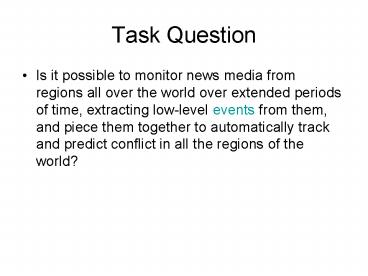Task Question - PowerPoint PPT Presentation
Title:
Task Question
Description:
Task Question Is it possible to monitor news media from regions all over the world over extended periods of time, extracting low-level events from them, and piece ... – PowerPoint PPT presentation
Number of Views:92
Avg rating:3.0/5.0
Title: Task Question
1
Task Question
- Is it possible to monitor news media from regions
all over the world over extended periods of time,
extracting low-level events from them, and piece
them together to automatically track and predict
conflict in all the regions of the world?
2
The Ares project
http//ares.cs.rice.edu
Rice Event Data Extractor
Singularity detection
Models
Online Information Sources
Hubs Authorities
Over 1 million articles on the Middle East
from 1979 to 2005 (filtered automatically)
AP, AFP, BBC, Reuters,
3
Analysis of wire stories
Relevance filter
Singularity detection on aggregated events data
Hubs and authorities analysis of events data
4
Embedded learner design
- Representation
- Identify relevant stories, extract event data
from them, build time series models and
graph-theoretic models. - Learning
- Identifying regime shifts in events data,
tracking evolution of militarized interstate
disputes (MIDs) by hubs/authorities analysis of
events data - Decision-making
- Issuing early warnings of outbreak of MIDs
5
Identifying relevant stories
- Only about 20 of stories contain events that are
to be extracted. - The rest are interpretations, (e.g., op-eds), or
are events not about conflict (e.g., sports) - We have trained Naïve Bayes (precision 86 and
recall 81), SVM classifiers (precision 92 and
recall 89) Okapi classifiers (precision 93
and recall 87) using a labeled set of 180,000
stories from Reuters. - Surprisingly difficult problem!
- Lack of large labeled data sets
- Poor transfer to other sources (AP/BBC)
- The category of event containing stories is not
well-separated from others, and changes with time
Lee, Tran, Singer, Subramanian, 2006
6
Okapi classifier
- Reuters data set relevant categories are GVIO,
GDIP, G13 irrelevant categories 1POL, 2ECO,
3SPO, ECAT, G12, G131, GDEF, GPOL
Rel
New article
Irr
Okapi measure takes two articles and gives the
similarity between them.
Decision rule sum of top N Okapi scores in Rel
set gt sum of top N Okapi
scores in Irr set then
classify as rel else irr
7
Event extraction
8
Parse sentence
Klein and Manning parser
9
Pronoun de-referencing
10
Sentence fragmentation
Correlative conjunctions
Extract embedded sentences (SBAR)
11
Conditional random fields
We extract who (actor) did what (event) to whom
(target)
Not exactly the same as NER
12
Results
TABARI is state of the art coder in
political science
200 Reuters sentences hand-labeled with actor,
target, and event codes (22 and 02).
Stepinksi, Stoll, Subramanian 2006
13
Events data
177,336 events from April 1979 to October 2003 in
Levant data set (KEDS).
14
What can be predicted?
15
Singularity detection
Stoll and Subramanian, 2004, 2006
16
Singularities MID start/end
17
Interaction graphs
- Model interactions between countries in a
directed graph.
ARB ISR
EGY UNK AFD
PALPL
18
Hubs and authorities for events data
- A hub node is an important initiator of events.
- An authority node is an important target of
events. - Hypothesis
- Identifying hubs and authorities over a
particular temporal chunk of events data tells us
who the key actors and targets are. - Changes in the number and size of connected
components in the interaction graph signal
potential outbreak of conflict.
19
Hubs/Authorities picture of Iran Iraq war
20
2 weeks prior to Desert Storm
21
Validation using MID data
- Number of bi-weeks with MIDS in Levant data 41
out of 589. - Result 1 Hubs and Authorities correctly identify
actors and targets in impending conflict. - Result 2 Simple regression model on change in
hubs and authorities scores, change in number of
connected components, change in size of largest
component 4 weeks before MID, predicts MID onset. - Problem false alarm rate of 16 can be reduced
by adding political knowledge of conflict.
Stoll and Subramanian, 2006
22
(No Transcript)
23
Current work
- Extracting economic events along with political
events to improve accuracy of prediction of both
economic and political events.
24
Publications
- An OKAPI-based approach for article filtering,
Lee, Than, Stoll, Subramanian, 2006 Rice
University Technical Report. - Hubs, authorities and networks predicting
conflict using events data, R. Stoll and D.
Subramanian, International Studies Association,
2006 (invited paper). - Events, patterns and analysis, D. Subramanian and
R. Stoll, in Programming for Peace
Computer-aided methods for international conflict
resolution and prevention, 2006, Springer Verlag,
R. Trappl (ed). - Four Way Street? Saudi Arabia's Behavior among
the superpowers, 1966-1999, R. Stoll and D.
Subramanian, James A Baker III Institute for
Public Policy Series, 2004. - Events, patterns and analysis forecasting
conflict in the 21st century, R. Stoll and D.
Subramanian, Proceedings of the National
Conference on Digital Government Research, 2004. - Forecasting international conflict in the 21st
century, D. Subramanian and R. Stoll, in Proc. of
the Symposium on Computer-aided methods for
international conflict resolution, 2002.
25
The research team































